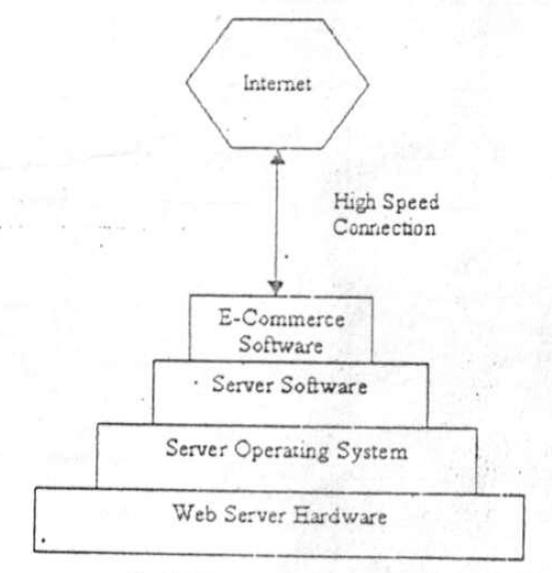Different Components of E-commerce
The technology and infrastructure used to develop the E-commerce application is the key to its success.
The hardware and software must be selected in such a way that they can fulfill the needs of the E-commerce application.
The following figure shows the components involved in E-commerce infrastructure.

1. Hardware:
A Web server hardware platform is one of the major components of the Ecommerce infrastructure on which the performance of the whole E-commerce application depends.
While selecting Web server hardware, the software that will run on the server of the E-commerce transactions to be processed must be considered.
The amount of the storage capacity and the computing power required depend on the volume of the E-commerce transaction to be processed.
If the exact requirements are not known in advance, then the hardware configuration should be highly scalable so that they can be upgraded to meet the requirements.
2. E - Commerce Softwares
Software is the main component that implements the E-commerce services and functionality. Software for E-commerce can be categorized in the following two types
Web server software:
Web server software is required in addition to the Web server operating system software.
It is used to implement some extra functionality such as security and identification and retrieval and sending of Web pages.
Web server software creates a Web log file that identifies things such as the URL of the visitor, the length of the visit and the search engine and the key words used to find the site.
Web server software includes website development tools such as HTML editor and Web page upload support.
E-commerce softwares:
With the growth of E-commerce, many applications have emerged— for example, the electronic shopping cart that tracks the items selected for purchase and their costs.
A typical E-commerce software must support the following processes:
Catalog management:
It is required to deliver the customized content to the screen or the GUI used by the customer.
The software used for catalog management combines the different product data formats into a standard format for viewing, aggregating and interacting catalog data into a central store.
Product configuration:
The Web-based product configuration software allows the user to build the product to their specifications without the intervention of the salespeople.
For example, Dell Computers and CISCO systems use configuration software to sell build-to-order and network processes to their customers over the Internet.
Shopping cart
A model known as shopping cart is used by Ecommerce sites to track the items that are selected for purchase; the shopping cart allows customers to view all the items selected by them.
The customers can add new items and remove the previously selected items from the shopping cart.
Transaction processing:
E-commerce transaction processing is used to process the data received from the. Shopping cart and to calculate the total cost of the purchase.
Web traffic data analysis:
It is required to analyze all the data captured in the Web log file. The analysis is essential to improve the Website performance.
Advantages of E-Commerce
Applications of E-Commerce
E-Commerce Architecture
Business Models of E-Commerce
B2C Model
Back to E-Commerce Questions